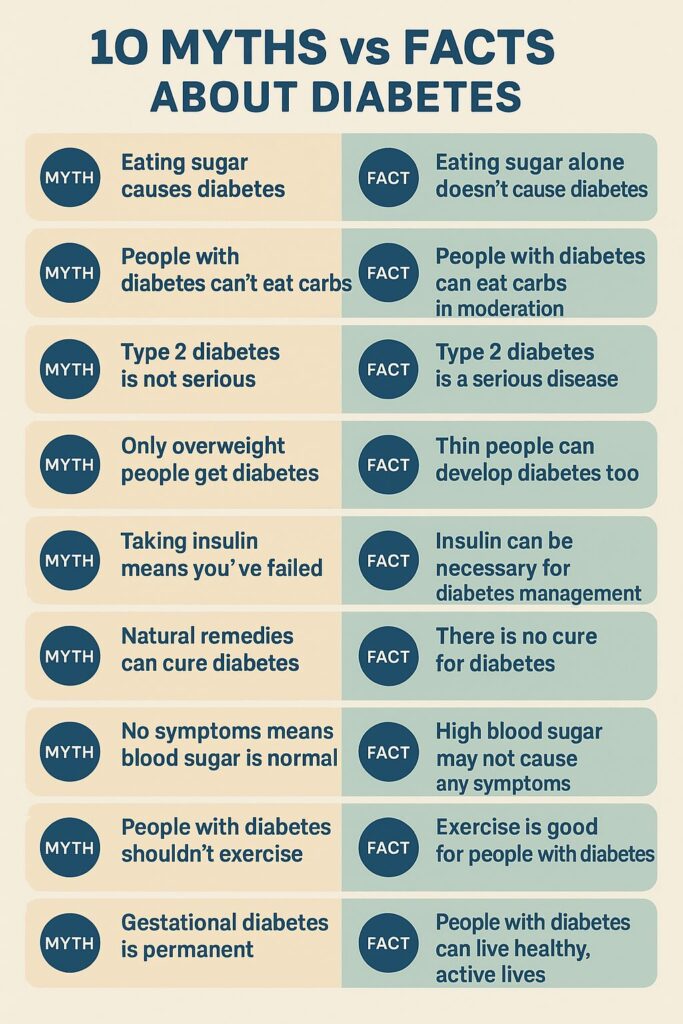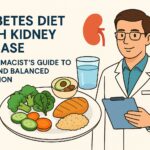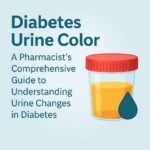Living with diabetes is already challenging—misinformation only makes it worse. As a licensed pharmacist, I often encounter patients who are overwhelmed by the myths and half-truths that circulate online and even within communities.
In this article, I will debunk 10 of the most common diabetes myths with evidence-based insights, clinical reasoning, and compassion. Whether you’re newly diagnosed or a caregiver, this guide will help you separate fact from fiction and manage diabetes with confidence.
Myth #1: Eating Sugar Causes Diabetes
The Myth:
“Eating too much sugar directly causes diabetes.”
The Truth:
While excessive sugar intake may contribute to weight gain and insulin resistance—especially in Type 2 diabetes—it is not the sole cause of diabetes.
• Type 1 diabetes is an autoimmune condition where the immune system attacks insulin-producing cells in the pancreas.
• Type 2 diabetes is largely influenced by genetics, lifestyle, and metabolic health—not just sugar.
Data Point:
According to the American Diabetes Association (ADA), sugar intake is just one piece of a larger puzzle. Overweight individuals have a 2–6 times higher risk of developing Type 2 diabetes, but even people with a healthy weight can develop it.
Myth #2: People with Diabetes Can’t Eat Carbs
The Myth:
“Carbohydrates are off-limits if you have diabetes.”
The Truth:
Not all carbs are bad. The body needs carbohydrates for energy. The key is choosing low-glycemic, fiber-rich carbs and managing portion sizes.
Examples of Diabetes-Friendly Carbs:
• Whole grains (quinoa, brown rice, oats)
• Legumes (chickpeas, lentils)
• Vegetables and fruits (in moderation)
Clinical Insight:
I advise patients to focus on total carbohydrate intake per meal and combine carbs with proteins or healthy fats to reduce blood sugar spikes.
Myth #3: Type 2 Diabetes Is Mild and Not Serious
The Myth:
“Type 2 diabetes isn’t dangerous—it’s the ‘better’ kind.”
The Truth:
Type 2 diabetes can lead to severe complications if left unmanaged, including:
• Heart disease
• Kidney damage (diabetic nephropathy)
• Vision loss (diabetic retinopathy)
• Neuropathy and amputations
Fact Check:
The CDC reports that type 2 diabetes accounts for 90–95% of all diabetes cases and is a leading cause of death and disability.
Myth #4: Only Overweight People Get Diabetes
The Myth:
“Thin people don’t get diabetes.”
The Truth:
Being overweight increases risk, but genetics, ethnicity, and age also play major roles.
• Type 1 diabetes often occurs in children or lean adults.
• Type 2 diabetes can occur in normal-weight individuals, especially if they have a family history or lead a sedentary lifestyle.
Pharmacist Insight:
I’ve had many normal-weight patients with type 2 diabetes who were shocked by their diagnosis. This reinforces the importance of screening and lifestyle awareness, regardless of body size.
Myth #5: Insulin Is a Sign of Failure
The Myth:
“Needing insulin means you failed at controlling your diabetes.”
The Truth:
Diabetes is a progressive disease. Over time, the pancreas may produce less insulin, and medication adjustments—including insulin—are part of proper management, not failure.
Clinical Perspective:
I reassure patients that insulin is not a punishment—it is a tool. Many feel dramatically better after starting it and achieve better A1C levels.

Myth #6: Natural Remedies Can Cure Diabetes
The Myth:
“Herbs and natural products can completely cure diabetes.”
The Truth:
There is no scientifically validated cure for diabetes. Some natural remedies may help control blood sugar—but they should never replace prescribed treatment.
Examples of Misleading “Cures”:
• Bitter melon
• Fenugreek seeds
• Cinnamon megadoses
References:
The Mayo Clinic emphasizes that while supplements may complement treatment, they cannot cure diabetes.
Myth #7: If You Don’t Have Symptoms, Your Diabetes Isn’t Serious
The Myth:
“No symptoms? No problem.”
The Truth:
Diabetes is often called a “silent disease.” High blood sugar can silently damage organs over time, even if you feel fine.
Common “Silent” Damage Includes:
• Retinal damage
• Kidney dysfunction
• Nerve damage
Pharmacist Tip:
Regular A1C and fasting glucose tests are crucial—even when you’re asymptomatic.
Myth #8: People with Diabetes Shouldn’t Exercise
The Myth:
“Exercise is dangerous for diabetics—it can make blood sugar drop too low.”
The Truth:
Exercise is one of the most beneficial tools for managing diabetes. It helps:
• Improve insulin sensitivity
• Lower blood sugar levels
• Promote weight loss
• Boost cardiovascular health
Guidelines:
• Aim for 150 minutes of moderate-intensity activity weekly (ADA recommendation).
• Always check your blood sugar before and after workouts if you’re on insulin or sulfonylureas.
Myth #9: Gestational Diabetes Goes Away After Delivery
The Myth:
“Once the baby is born, gestational diabetes disappears forever.”
The Truth:
While gestational diabetes usually resolves after delivery, up to 50% of women with GDM develop type 2 diabetes later in life.
Postpartum Steps:
• Blood sugar testing 6–12 weeks after birth
• Annual diabetes screening
• Maintaining healthy weight and diet
Source:
According to the CDC, lifestyle changes post-pregnancy are essential.
Myth #10: You Can’t Live a Normal Life With Diabetes
The Myth:
“Diabetes limits your life permanently.”
The Truth:
With proper management, people with diabetes can live full, active lives. Managing diabetes is about adaptation, not limitation.
Real-Life Success Tips:
• Follow a balanced, consistent diet
• Stay active
• Monitor blood sugar regularly
• Stay informed and connected to your healthcare team
Frequently Asked Questions (FAQs)
Can you reverse type 2 diabetes completely?
You can put type 2 diabetes into remission through weight loss, diet, and exercise, but it is not considered “cured.” Ongoing management is key.
Is it okay to eat fruit if I have diabetes?
Yes—fruits like berries, apples, and citrus have fiber and nutrients. Portion control is important due to natural sugar content.
Are artificial sweeteners safe for diabetics?
Most are safe in moderation. However, some people experience gastrointestinal symptoms. Always check with your healthcare provider.
How often should I check my blood sugar?
Depends on your treatment plan. Insulin users should check 3–4 times daily; others may do it once a day or a few times per week.
What’s the normal A1C level?
An A1C below 5.7% is normal. 5.7–6.4% is prediabetes. 6.5% or higher on two occasions confirms diabetes.
Key Takeaways
• Diabetes is often misunderstood, even by those living with it.
• Myths can lead to poor choices and missed opportunities for better health.
• Evidence-based care, led by your healthcare team, is your best ally.
• As a pharmacist, I encourage you to ask questions, seek clarity, and never fall for “quick fixes.”
Medical Disclaimer
This blog is for informational purposes only and does not substitute professional medical advice. Please consult your doctor or a registered healthcare provider before making any changes to your diabetes care plan.




Pingback: Which Is the Worst: Type 1 or Type 2 Diabetes? - Pharma Heals